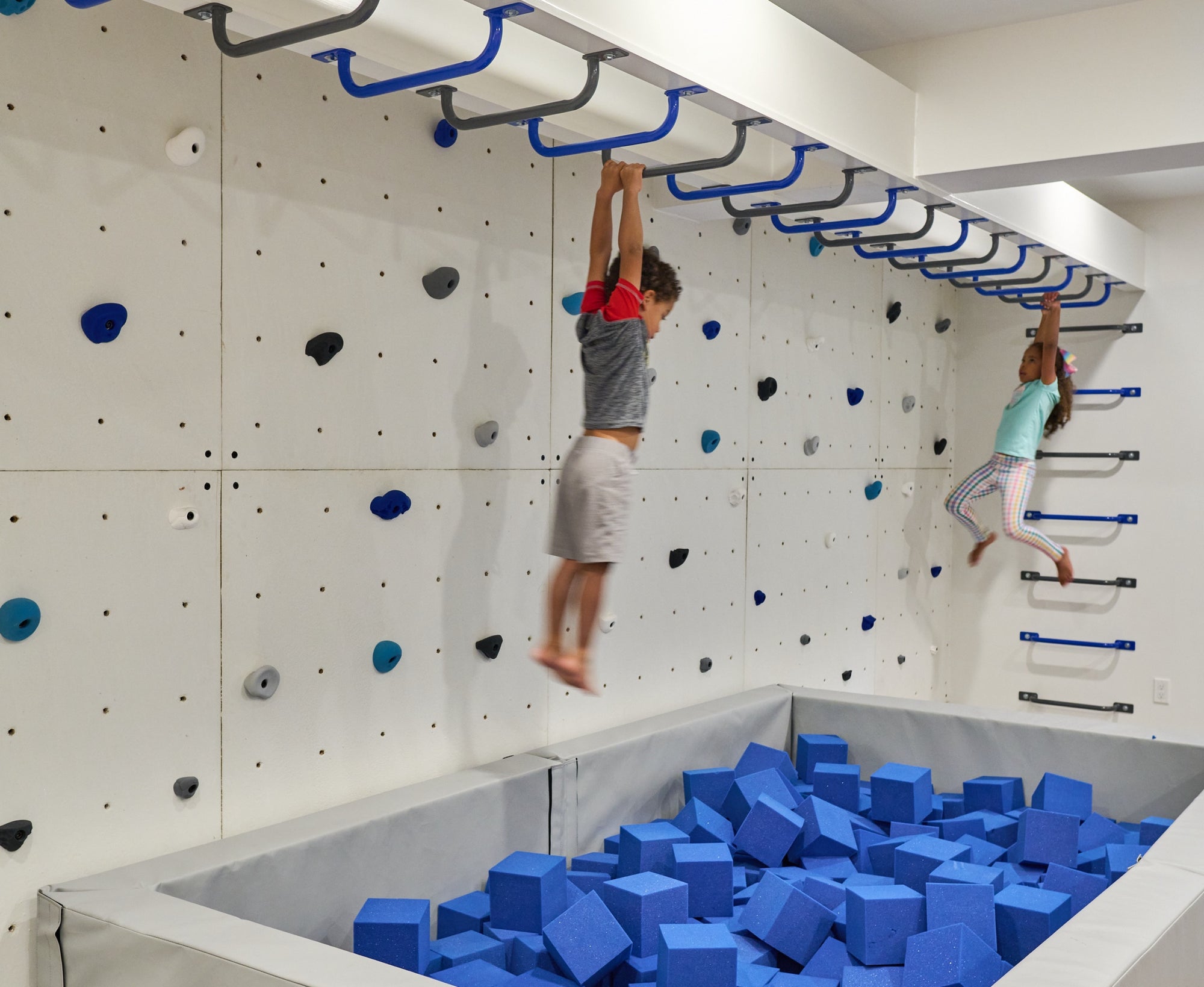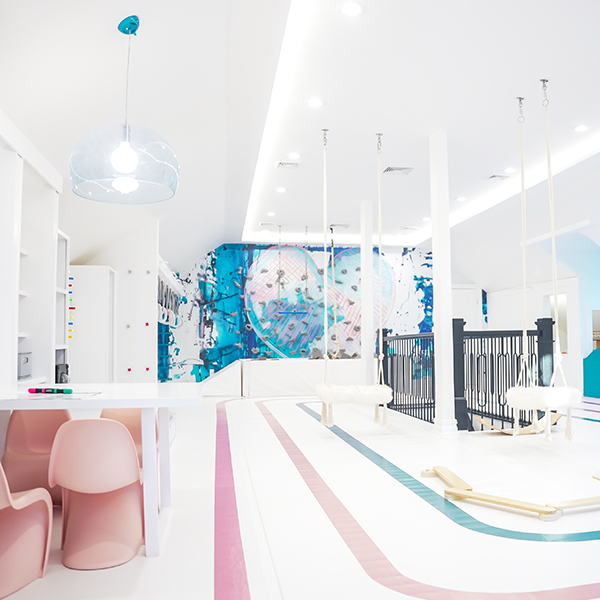Childhood is a time of boundless exploration, with each day holding the promise of new adventures. The joy of scaling a wall, finding a foothold, and reaching the top is unmatched. It builds not just muscles but character and determination. Among the thrilling activities for energetic children, the various types of rock climbing stand out as a celebrated choice, bringing outdoor challenges into the heart of your home.
At Project Playroom, we design playrooms that capture the imagination and invite adventure. Our designer rock wall panels add sophistication and sensory stimulation to your child's play space. They're not just play equipment; they're an invitation to embark on a climb that teaches resilience, problem-solving, and the joy of success.
Traditional Climbing Walls
A traditional climbing wall is what usually comes to mind when one thinks about rock climbing. It's a tall structure, often mirroring the experience of outdoor rock climbing with the use of harnesses and ropes for safety. Implementing a traditional climbing wall in a playroom can transform the space into an adventurous zone. It encourages children to develop strength, coordination, and problem-solving skills as they figure out the best path to reach the top. The use of safety gear, like harnesses, also teaches them the importance of safety precautions while fostering a love for physical activity.
Bouldering Walls
Bouldering is a form of rock climbing performed on artificial walls with small rock formations without the use of ropes or harnesses. A bouldering wall in a playroom provides an excellent way for kids to practice climbing at a safer, more accessible height. Typically, these walls are shorter than traditional walls, and they are complemented by thick mats placed on the floor to cushion any falls.
Bouldering challenges children to use strength and strategy to navigate routes. Since there's no reliance on climbing gear, climbers focus on movement and technique, boosting their physical strength and mental acuity. Parents appreciate bouldering walls for their ease of supervision and the reduced need for extensive safety equipment. The lower height and the problem-solving nature of bouldering make it a favorite among kids, fostering an environment of playful learning and physical development without the intimidation factor.
Climbing Towers
Climbing towers offer a distinct vertical challenge, often incorporating elements from both traditional climbing walls and bouldering. These structures are designed to stand alone, with routes on all sides, making them a compact and efficient use of space in a playroom. Climbing towers can include features like overhangs, chimneys, and even slide descents, making the climb up just as fun as the way down. They represent a more realistic climbing experience, simulating the outdoor adventure within the safety of an indoor environment.
Children are drawn to climbing towers because of their engaging and dynamic nature. The varied routes and features cater to a wide range of skill levels, ensuring that every child finds a path that's challenging yet achievable. Climbing towers not only enrich children's playtime with physical activity but also spark their imagination, turning ordinary playtime into an extraordinary adventure. The multi-sided climbing possibility also allows for more than one child to climb at the same time, promoting social interaction and teamwork among young climbers.
Rope Ladders and Nets
Rope ladders and nets introduce a dynamic element to a child's climbing experience, promoting balance and coordination in ways traditional rock climbing structures might not. The flexibility of the rope ladder rungs tests kids' stability and grip strength, offering an adventurous feel reminiscent of swaying bridges in adventure parks. Nets, on the other hand, provide a wide climbing area, allowing children to use both hands and feet in various positions, which helps them develop motor skills and muscle coordination. These options can be a novel choice for those looking to supplement rock climbing structures or for playrooms with limited wall space.
Outfitting a playroom with rope ladders and nets does not demand extensive setup. These structures, which typically involve secure anchors and heavy-duty rope materials, lend themselves to the existing architecture of the room, like beams or sturdy fittings on the walls. The inherent flexibility of these climbing accessories allows children to create their pathways upwards, sideways, or diagonally, presenting them with boundless opportunities for imaginative and physical play.
Geodesic Climbing Domes
Geodesic climbing domes have gained traction as a backyard staple, but they can also be engaging indoor playground equipment when space allows. These domes consist of interconnected triangles based on geodesic designs, creating a sturdy, self-supporting spherical structure. They stand out with their ability to withstand heavy loads while offering numerous hands and footholds for climbers. The spherical shape promotes spatial awareness and planning as children decide on their next move, making the activity both mentally and physically stimulating.
These domes offer a 360-degree climbing experience, prepping kids to approach challenges from multiple angles. The spherical design inherently requires climbers to shift their center of gravity frequently, enhancing their proprioceptive sense and agility. Because of their structure, geodesic domes can support many climbers simultaneously, encouraging social interactions and teamwork.
Rock Climbing Ramps
Rock climbing ramps, often referred to as slabs in the climbing community, bring a unique challenge to the indoor climbing experience. Slabs are climbing surfaces with a gentler incline than vertical walls, requiring climbers to rely more on balance and careful foot placement than upper body strength. This kind of climbing structure teaches children about weight distribution and precision, honing their skills in a way that overhanging walls can't replicate.
Implementing a rock climbing ramp in a playroom demands thoughtful consideration of the angles and surface materials to ensure they are engaging yet safe for kids. Textured surfaces, along with an array of holds, can create paths that develop a child's confidence in their movements. Climbing ramps can serve as an excellent starting point for novices. They are also perfect for more experienced young climbers, allowing them to advance their technique and develop an understanding of their body's capabilities in relation to gravity.
Modular Climbing Panels
Modular climbing panels offer a versatile and customizable climbing experience that can fit any space, no matter the size or shape. These panels can be arranged in an infinite number of ways to create climbing routes that vary in difficulty, making them an ideal choice for families with climbers of different ages and skill levels. The simplicity of adjusting and rearranging the panels means that the climbing environment can evolve with the climber, providing continual challenges as their abilities grow. This flexibility makes modular panels a smart investment for those looking to bring the climbing gym experience into the home without committing to a single, permanent structure.
The design appeal of modular panels is another significant advantage. They come in various colors and textures, allowing them to blend seamlessly with a playroom's decor or stand out as a vibrant focal point. Safety features, such as padding around the base and edges, can be integrated to ensure a soft landing for any accidental falls. This combination of functional fitness with aesthetic consideration encourages children to engage in physical play in an environment that feels personally tailored to their interests and abilities, fostering a lifelong engagement with physical activity.
Freestanding Climbing Structures
Freestanding climbing structures are an all-encompassing solution for indoor climbing, designed to accommodate various climbing activities without the need for wall installation. These structures can include elements like rope bridges, ladders, and slide poles, making them an adventure playground that children can explore vertically and horizontally. One of the pinnacle benefits of freestanding climbing structures is their portability. Unlike fixed climbing walls, these can be moved and rotated within a space, allowing for refreshment of the play area's layout and the introduction of new challenges to keep young climbers intrigued and motivated.
Strength and Creativity in Rock Wall Holds
It's not just about the climb—it's about the journey and every grip along the way. Our rock wall holds are engineered for hands to grasp securely and for feet to step confidently. They're the very points of contact where tenacity meets whimsy, and every laugh and giggle is a sound of a triumph earned, a summit reached, a creativity nurtured. Contact us to start your climb to a transformative playroom experience.



